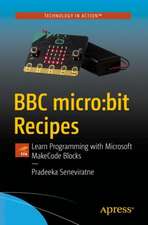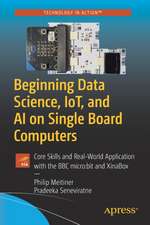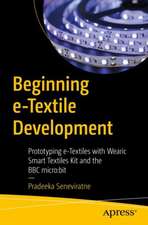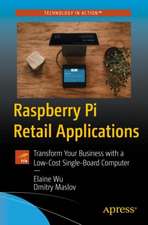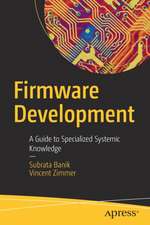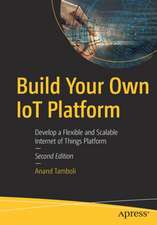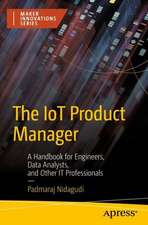Building Arduino PLCs: The essential techniques you need to develop Arduino-based PLCs
Autor Pradeeka Seneviratneen Limba Engleză Paperback – 9 feb 2017
A comprehensive shopping guide includes the hardware and software components you need in your tool box. You will learn to use Arduino UNO, Arduino Ethernet shield, and Arduino WiFi shield.
Building Arduino PLCs shows you how to build and test a simple Arduino UNO-based 5V DC logic level PLC with Grove Base shield by connecting simple sensors and actuators. You will also learn how to build industry-grade PLCs with the help of ArduiBox.
What You'll Learn
- Build ModBus-enabled PLCs
- Map Arduino PLCs into the cloud using NearBus cloud connector to control the PLC through the Internet
- Use do-it-yourself light platforms such as IFTTT
- Enhance your PLC by adding Relay shields for connecting heavy loads
Engineers, designers, crafters, and makers. Basic knowledge in electronics and Arduino programming or any other programming language is recommended.
Preț: 270.08 lei
Preț vechi: 337.60 lei
-20% Nou
Puncte Express: 405
Preț estimativ în valută:
51.69€ • 56.12$ • 43.42£
51.69€ • 56.12$ • 43.42£
Carte tipărită la comandă
Livrare economică 18-24 aprilie
Preluare comenzi: 021 569.72.76
Specificații
ISBN-13: 9781484226315
ISBN-10: 1484226313
Pagini: 183
Ilustrații: XIII, 183 p. 145 illus., 128 illus. in color.
Dimensiuni: 155 x 235 x 11 mm
Greutate: 0.29 kg
Ediția:1st ed.
Editura: Apress
Colecția Apress
Locul publicării:Berkeley, CA, United States
ISBN-10: 1484226313
Pagini: 183
Ilustrații: XIII, 183 p. 145 illus., 128 illus. in color.
Dimensiuni: 155 x 235 x 11 mm
Greutate: 0.29 kg
Ediția:1st ed.
Editura: Apress
Colecția Apress
Locul publicării:Berkeley, CA, United States
Cuprins
Chapter 1: Getting Ready for the Development Environment
Chapter 2: Arduino, Ethernet, and WiFi
Chapter 3: Arduino at Heart
Chapter 4: Your First Arduino PLC
Chapter 5: Building with and ArduiBox
Chapter 6: Write PLC-style Applications with plcLib
Chapter 7: Modbus
Chapter 8: Mapping PLCs into the Cloud Using NearBus Cloud Connector
Chapter 9: Building a Better PLC
Notă biografică
Pradeeka Seneviratne is a software engineer with over 10 years of experience in computer programming and systems designing. He loves programming embedded systems such as Arduino and Raspberry Pi. Pradeeka started learning about electronics when he was at primary college by reading and testing various electronic projects found in newspapers, magazines, and books.
Pradeeka is currently a full-time software engineer who works with highly-scalable technologies. Previously, he worked as a software engineer for several IT infrastructure and technology servicing companies, and he was also a teacher for information technology and Arduino development.
He researches how to make Arduino-based unmanned aerial vehicles and Raspberry Pi-based security cameras and is the author of the Internet of Things with Arduino Blueprints [Packt Publishing]
Pradeeka is currently a full-time software engineer who works with highly-scalable technologies. Previously, he worked as a software engineer for several IT infrastructure and technology servicing companies, and he was also a teacher for information technology and Arduino development.
He researches how to make Arduino-based unmanned aerial vehicles and Raspberry Pi-based security cameras and is the author of the Internet of Things with Arduino Blueprints [Packt Publishing]
Textul de pe ultima copertă
This book presents the fundamentals of PLCs and explains in a practical approach how to draw Ladder Logic diagrams to represent PLC design methods for wide variety of automated applications.
Building Arduino PLCs starts by explaining how to build and test a simple Arduino-based 5V DC PLC with Arduino hardware and Grove base shield. You'll then learn how to build 12V DC PLC with Arduino hardware, relays, and various passive components.
Then the final part of the book will show readers how to control 120v/240V applications with PLCs by enhancing the design with optocouplers and relays. The Arduino development environment, including Arduino UNO, Arduino Ethernet board, Arduino Ethernet shield, and Arduino WiFi shield are also featured in building a set of simple to complex PLCs.
Building Arduino PLCs starts by explaining how to build and test a simple Arduino-based 5V DC PLC with Arduino hardware and Grove base shield. You'll then learn how to build 12V DC PLC with Arduino hardware, relays, and various passive components.
Then the final part of the book will show readers how to control 120v/240V applications with PLCs by enhancing the design with optocouplers and relays. The Arduino development environment, including Arduino UNO, Arduino Ethernet board, Arduino Ethernet shield, and Arduino WiFi shield are also featured in building a set of simple to complex PLCs.
Caracteristici
The first Arduino book about programmable logic controllers Knowledge gained through this book can be extended to industrial and non-industrial automation projects The projects build in the book are based on IoT and are cloud-supported








